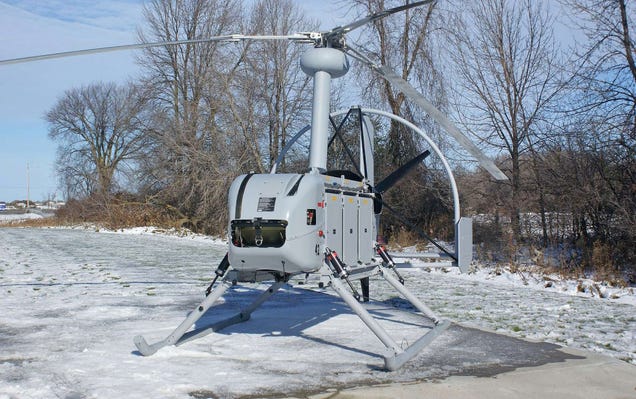DRONE gyro
CQ-10B
Snowgoose Is The Pentagon's Low-Cost Resupply Drone Of Dreams
http://foxtrotalpha.jalopnik.com/snowgoose-is-the-pentagons-low-cost-resupply-drone-of-d-1699921499http://www.mmist.ca/Media/Docs/Brochures/SnowGoose_Brochure.pdfKnown as the CQ-10B, this system does not require launch from a speeding vehicle, as it simply powers forward using it propeller’s thrust until its rotor head generates enough lift to pull the drone off the ground. Because this system requires minimum infrastructure and can launch and land nearly vertically, it offers an even more reliable logistical bridge for austere operating locations.
Being able to land anywhere and return on command with no additional help gives the CQ-10B a capability the CQ-10A did not have. It also offers nearly double the speed and range as its predecessor, plus other advantages, like superior headwind penetration.
When you think creatively about what can be done with CQ-10B, it clearly offers some pretty awesome potential that don’t exist with any other unmanned platform today. It can be air-dropped with a special forces unit and then deployed by that unit to provide overwatch and communications relay support (or potentially very light air support) for their mission. When the mission concludes, the aircraft can simply fly to a recovery location.
When using guided ‘smart’ cargo parachute systems, of which MMIST makes multiple types, a CQ-10B can be dropped with them and their supplies. Once the unit on the ground has recovered the supplies from the guided parachutes, they can be packed aboard a CQ-10B that will autonomously fly them to friendly territory for reuse.
SOCOM is not alone in their interest when it comes the Snowgoose. The Office of Naval Research has taken a great interest in the gyrocopter-like CQ-10B, with the unit seen as an ideal, low-cost, multi-role sea-to-shore logistics platform . Whether it will be procured in large numbers remains unknown, but it was a featured exhibit at the biannual Naval Future Force Science and Technology Expo just this year. Here is a video of from 2008 of the CQ-10A shipboard resupply concept (since then the Navy has turned to the CQ-10B model) :
Clearly, the Navy’s Special Warfare Command could also make good use of the Snowgoose system, as sending a helicopter from a ship for emergency resupply to units deep in enemy territory may be impossible. Risking a CQ-10, with its tiny radar signature, may be much more palatable.
Where the Snowgoose might shine the most is not in the hands of the military at all, but for civilian and commercial applications. For difficult locations all over the world, especially in regards to places like Alaska, where very small groups of people live hundreds of miles away from population centers, the Snowgoose could be the perfect low-cost resupply vehicle.
Today, light aircraft are mainly used for these sorts of resupply missions, but they are hampered by visibility and cost. The Snowgoose, with its autonomous GPS navigation, simplified design, and lack of a pilot, could provide more effective service at a minimal cost. Additionally, with the CQ-10B gyrocopter capability, minimal training would be required to launch the aircraft on its way back home. Theoretically, just aligning the machine with an open area and hitting a button could do the trick.
Overseas, in places like Africa, light aircraft have to risk very rough terrain with minimal chances of being found by search and rescue teams should something go wrong. Even worse, they might fly over conflict zones in order to provide humanitarian aid to indigenous peoples. The Snowgoose could be a perfect alternative. The same goes for resupply science and energy exploration expeditions in remote areas.
There are so many other missions the aircraft could perform here at home, including border patrol, disaster relief, overhead surveillance, search and rescue. The list just keeps on going. Even oil platforms could use the system as a much lower cost way of performing light logistics than expensive twin engine helicopters.
Currently, FAA rules are an issue when it comes to adapting an aircraft like the CQ-10 to civilian applications. However, this will, and should, change in the not-so-distant future. Until then, MMIST will have to rely on military purchases to keep the Snowgoose alive and thriving.
Snowgoose is such a relevant and simple solution to so many problems that it is somewhat bewildering that it has not already been fielded in larger numbers, especially the CQ-10B model. Then again, it is by no means a glamorous machine. It is a slow, tubby, utilitarian, multi-role tool.
Hopefully its extreme cost effectiveness ($650k per machine and hundreds of dollars per hour to operate) will overpower its weak sex appeal in the minds of investors. This drone has the power to change aviation forever.
Tyler Rogoway is a defense journalist and photographer who maintains the website Foxtrot Alpha for Jalopnik.com You can reach Tyler with story ideas or direct comments regarding this or any other defense topic via the email address
[email protected]